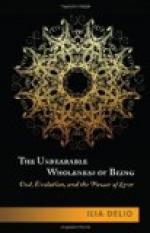In conclusion I will attempt to elucidate a group of phenomena which play a part, important though often ignored, in the emotional life of the present day. They are related to the subject under discussion, inasmuch as they, too, are the result of a lack of harmony between sensuousness and love. As long as sensuousness is felt and understood as a natural element, and one which does not under normal circumstances enter consciousness as a distinct principle, the emotional sphere which may be designated as demoniacal-sexual and obscene, does not exist. Not until sensuousness is confronted by a higher principle, a now solely acknowledged spiritual-divine principle, will natural life, and particularly normal sexuality, be stigmatised as low and ungodly, even as demoniacal. In proportion as the conception of God became more spiritual and divine, the conception of the devil became more horrible; the higher the soul soared, the deeper sank the body. This philosophy of pure spirituality was expressed by St. Bernard of Clairvaux in the following words: “Oh, soul, stamped with the image of God, adorned with His semblance, espoused to faith, endowed with His spirit, redeemed by His blood, the compeer of angels, invested with reason—what hast thou in common with the flesh, for which thou must suffer so much?... And yet it is thy dearest companion! Behold, there will come a day when it shall be a miserable, pallid corpse, food for worms! For however beautifully it may be adorned, yet it is nothing but flesh!” The man of the later Middle Ages, and especially the cleric, who was completely dominated by the contrast of the ascetic and the sexual, feared the devil more than he loved God, and regarded the sensual temptations which beset his excited, superstitious and eternally unsatisfied imagination as sent by the devil. The naivete of sensuality had passed away for ever; as goodness was looked upon as divine and supernatural, nature and natural instincts were condemned. Man was torn asunder.
But the devil was not only feared, he was also worshipped. A devil-worship, the details of which have been little studied, existed from the tenth to the fourteenth century (when it reached its climax), side by side with the worship of God. The greater the dread of heresy and witchcraft, the greater became the number of men who, despairing of salvation, prostrated themselves before the devil, whom they seemed unable to escape (a single evil thought was sufficient to doom their souls to eternal damnation), in the hope that he would at least save their bodies from the stake and vouchsafe them the pleasures of this world. Satan promised his worshippers unlimited pleasure; he became the redeemer of those whom the clergy persecuted. It is asserted that his worship consisted in an obscene parody of the Mass; according to Michelet, the body of a female worshipper served as the altar on which a toad was consecrated and partaken of instead of the Host. The adept solemnly renounced Jesus and did homage to Satan by kissing his image.




